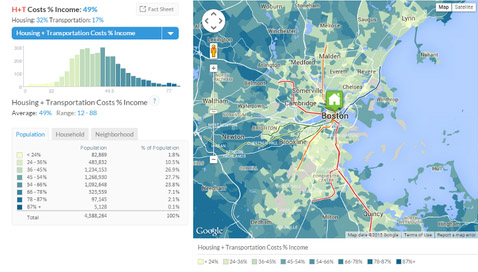CHICAGO – Even though gas prices are down, costs for transportation are still high. How much we spend is based on where we live, according to data gathered by the Center for Neighborhood Technology (CNT) through the new version of its groundbreaking Housing and Transportation (H+T®) Affordability Index.
The New York City region came in 1st, with the Chicago and Washington DC metro areas coming in at 2nd and 3rd respectively on the list for metropolitan areas of a million or more. For a full list click here.
CNT, a national urban sustainability and economic development nonprofit, created the iconic H+T Index and ranked metropolitan areas in the nation to show the true cost of living when accounting for transportation spending.
Launched in 2006, the H+T Index offers helpful comparison maps for 200,000 neighborhoods (covering 94 percent of the US population). Costs can be seen from the regional down to the neighborhood level.
The H+T Index’s most significant new features include:
- The True Cost of Driving Tool shows how changes in the price of gas impacts the affordability and sustainability of different home locations
- Map views with quick links to key measures, such as access to jobs via transit, greenhouse gas (GHG) emissions, and more
- Customized, dynamic, and printable Fact Sheets for any municipality, county, CBSA, metropolitan planning organization, or Congressional District in the Index
- CNT’s All Transit™ data includes stops and frequencies for 507 agencies nationwide
H+T Index data can also be downloaded for use in mapping, policy, planning and other applications.
“Transportation officials, metropolitan planning organizations, and governments all over the country use the H+T Index to make their cities more affordable, efficient and resilient, while consumers can use it to determine where to purchase a home,” CNT President Scott Bernstein said.
The traditional measure of affordability recommends that housing cost no more than 30 percent of household income. Using this standard, a little over half (55 percent) of US neighborhoods are considered “affordable” for the national typical household. However, that percentage drops to 26 percent when the benchmark fails to take into account transportation costs, which are typically a household’s second-largest expenditure. The H+T Index offers an expanded view of affordability, one that combines housing and transportation costs and sets the benchmark at 45% of household income.
The Index shows that transportation costs vary between and within regions depending on neighborhood characteristics. People who live in location-efficient neighborhoods—compact, mixed-use, and with convenient access to jobs, services, transit and amenities—tend to have lower transportation costs.
“The current low costs of fuel make the new True Cost of Driving Tool especially timely,” said Linda Young, Research Director at CNT. “Cities and neighborhoods are relatively fixed, but gas prices can change dramatically in just a few weeks. What if gas prices spike, or return to sustained highs? All of a sudden, auto-dependent neighborhoods become a lot less affordable.”
Along with the H+T Index, CNT also released a new resource called the Location Efficiency Hub to help planners, policy makers, and housing professionals create communities that allow people and goods to move around without wasting energy, time, and money.
Visit the new H+T Index at htaindex.cnt.org.





 Strengthening Transit Through Community Partnerships
Strengthening Transit Through Community Partnerships